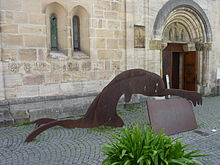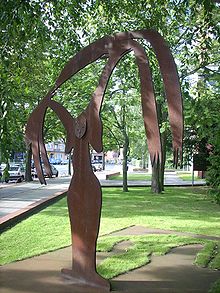Menashe Kadishman

Menashe Kadishman ( Hebrew מנשה קדישמן; * August 21, 1932 in Tel Aviv ; † May 8, 2015 in Ramat Gan ) was an Israeli draftsman , painter and sculptor . He was one of the most important artists in Israel and lived in Tel Aviv.
Works
In 1968 Kadishman took part in the 4th documenta in Kassel in the sculpture department with two metal and glass sculptures . He was also represented at several other biennials .
He was a participant in the first German sculpture symposium, the Kaisersteinbruch sculpture symposium , in 1961 in Gaubüttelbrunn near Kirchheim in Lower Franconia .
In the Jewish Museum Berlin is Kadishman will install Shalechet (Fallen Leaves): There are over 10,000 iron plates on the floor, cut into the faces, mouths opened like a scream. The visitors walk over these faces, which lie in several layers, creating a metallic sound.
Another work by Kadishman stands in front of the Dominican monastery in Braunschweig with the sculpture Pieta . Like a sheet of paper, he cut the outlines of a figure out of a thick steel plate and bent it upwards at a 90-degree angle. A woman can be seen carrying her dead son in her arms stretched upwards as if accusingly.
In Salzgitter, Menashe Kadishman is represented on the Salzgitter-Bad sculpture trail in Salzgitter-Bad with a monumental steel sculpture The Kiss .
The sculpture Mourning (Mourning) has stood in front of the west facade of the Johanniskirche in Schwäbisch Gmünd since 1996 . The grieving woman is bent over the coffin of her child. The sculpture is a reminder that Johannisplatz was one of the city's cemeteries until 1803.
Another publicly accessible sculpture is exhibited at the Schaumainkai in Frankfurt.
In Israel, Kadishman was mainly known for depicting people and sheep. It is an allusion to the story in the Old Testament that Abraham wants to sacrifice his son Isaac at God's command. The person who sacrifices his son (himself) for God (cf. sacrifice of Isaac ), for Kadishman this seemed to be the way of salvation. This suggests his image Way to Eden (way to paradise), which shows a sheep as the keeper of the way (cherub = guardian of paradise).
Kadishman's sheep painted with oil on canvas are also known. In an exhibition in Israel he set up thousands of these sheep as a flock.
In 1995 he was awarded the Israel Prize .
Museums and private collections (selection)
- Art Gallery of Ontario , Toronto (Canada);
- Centro d'Arte Contemporanea, Prato (Italy);
- Dominican Monastry Collection, Braunschweig (FRG);
- Gabi and Ami Brown Collection, Tel Aviv (Israel);
- Hara Museum of Contemporary Art , Tokyo (Japan);
- Helen and Jerome Stern Collection, New York (USA);
- Herta and Paul Amir Collection, Los Angeles (USA);
- The Israel Museum , Jerusalem (Israel);
- Jewish Museum Berlin (FRG);
- Lehmbruck Museum of the City of Duisburg (FRG);
- Lizi and Zeev Avram Collection, London (GB);
- Muriel and Phill Bermann Collection, Pennsylvania (USA);
- Museum of Modern Art , New York (USA);
- National Art Gallery, Beijing (China);
- Seethaler Collection, Berlin (FRG);
- Tate Gallery , London (GB);
Individual evidence
Web links
- Literature by and about Menashe Kadishman in the catalog of the German National Library
- Materials by and about Menashe Kadishman in the documenta archive
| personal data | |
|---|---|
| SURNAME | Kadishman, Menashe |
| ALTERNATIVE NAMES | מנשה קדישמן (Hebrew) |
| BRIEF DESCRIPTION | Israeli draftsman, painter and sculptor |
| DATE OF BIRTH | August 21, 1932 |
| PLACE OF BIRTH | Tel Aviv |
| DATE OF DEATH | May 8, 2015 |
| Place of death | Ramat Gan |

